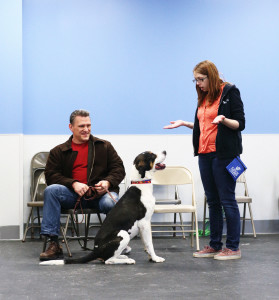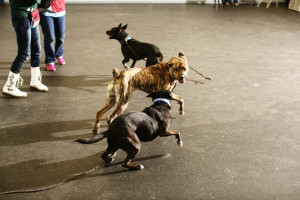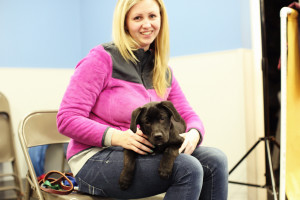Behavior Problem-Solving 101

“You’re so good in class, but how do I handle your ‘real-world’ behavior issues?!”
Every dog owner, even those madly in love with their dog (all of us), probably sees at least one behavior that they would like to change in their beloved pet. The art and science of training a dog to change their actions is called behavior modification. “B-mod” is as fascinating as it is useful. Coming up with the right solutions can be a complex process, but our goal today is to make the basics easy to understand. The three most important concepts are: Triggers, Management, and Training. Let’s look at each one in turn.
Triggers
A trigger is whatever situation causes your dog to perform the unwanted behavior. To see this clearly, let’s look at examples of some common behavior problems and their possible triggers:
- Unwanted behavior: Barking and lunging at other dogs during a walk
- Trigger: Seeing another dog from 20 feet away or less while on leash
- Unwanted behavior: Growling and snapping at owner’s friends
- Trigger: Being in the owner’s lap or arms when a person reaches out to pet the dog. Dog triggers when hand gets within 2 feet from their body.
- Unwanted behavior: Urinating on the carpet in the dining room (puppy)
- Triggers: Been indoors for over 2 hours, drank a lot of water after last play session, was not supervised or confined
If you want to change a behavior it is very important for you to know what triggers it. Behavior is rarely unpredictable. It is typically very predictable once you realize what to look for. Make a list of what situations cause the behavior to happen. Try to be very specific about details. Notice how we used distance and location above to make sure the details are clear. Once you identify the triggers, then you can figure out how to control them. This leads us to the next topic…
Management
Management is setting up situations so the dog doesn’t get triggered at all. Management is an important first step because it stops the dog from practicing the unwanted behavior. Let’s look at our examples from above again, this time adding in one or two management solutions for each issue:
-

Some dogs who play wonderfully OFF leash would still be aggressive when they see other dogs while ON leash.
Unwanted behavior: Barking and lunging at other dogs during a walk
- Trigger: Seeing another dog from 20 feet away or less while on leash
- Management: When walking the dog: avoid places that are busy with other dogs, cross the street or turn in the other direction when you see a dog that will come within 20 feet (ideally before the trigger distance hits)
- Unwanted behavior: Growling and snapping at owner’s friends
- Trigger: Being in the owner’s lap or arms when a person reaches out to pet the dog. Dog triggers when hand gets within 2 feet from their body.
- Management: Don’t pick up the dog or keep her in your lap when your friends come over, ask your friends not to reach out and pet the dog unless she comes over to them first.
- Unwanted behavior: Urinating on the carpet in the dining room (puppy)
- Triggers: Been indoors for over 2 hours, drank a lot of water after last play session, was not supervised or confined
- Management: Get the pup outside every 2 hours to empty his tank, watch water intake and increase frequency of going out when water intake goes up, do not allow pup to leave your sight or keep in a confined area during the housetraining period.

This pup loves being on Dana`s lap, but some adult dogs become protective of themselves or their owner if you try to pet them in this situation. For a dog like that, management = skipping lap time when guests are over.
Remember, management is a key first step because it stops the dog from practicing the unwanted behavior. This keeps the behavior pattern from getting stronger. In aggression cases, management is what keeps everyone safe. With nuisance problems like house soiling, management is what keeps everyone sane.
Management also opens up the opportunity for you to teach the dog new behaviors. That is where the next step, training, comes in. Training is fascinating because, once complete, it gives the dog the ability to face the triggers, but respond differently than it has in the past. We will explore training solutions for each of the above behavior problems and more in the next part of this series. Part two of this article is now available here.
~
Have you always had a way with dogs and wanted to do something more with this passion? At CATCH, we understand! Our national courses are designed to make you a pro and our Student Support Team would love to answer your questions and learn more about your goals. Click here to discover what you can learn at CATCH and how you can help dogs and their owners with pro skills of your own.






 Phone:
Phone: